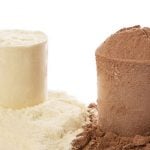There is a lot of anecdotal evidence out there that consuming citrus fruits (like oranges and lemons, for example) can help your body to build bigger and stronger muscles in a hurry – but this kind of anecdotal evidence really hasn’t been backed up by modern science until just recently.

A number of researchers in South Korea working in conjunction with one of their national universities has recently taken a good long look at the impact that citrus fruit may have on our bodies ability to build muscle faster while increasing our overall athletic capabilities at the same time.
Looking specifically at the ability for the biochemicals in citrus fruit, liminoids that are called obacunone and nomilin, to cause muscle growth specifically by interacting with bile acid receptors (TGR5), the research team was also surprised to discover that there are other substances in citrus fruit that offer anabolic properties, too.
This biochemical, sinsentin, is technically classified as a flavonoids and it has no fewer than five individual methoxy groups. There are a lot of other flavonoids in citrus as well that work in conjunction with sinsentin to increase overall anabolic benefits, but it’s the skyhigh level of bioavailability that sinsentin has compared to other flavonoids that make it such an impressive performance-enhancing solution.
The South Korean research team conducted this experiment working on muscular tissue of young laboratory rats that were between the ages of six weeks old and 12 months old. The older rats were found to have significantly less muscle tissue than the younger rats (no surprise there), but the impact that citrus fruits and sinsentins specifically had on their protein synthesis abilities and anabolic capacity were pretty remarkable.
At the end of the day, the research team actually pulled muscular cells from muscle tissue in both younger laboratory rats and older laboratory rats and allowed them to naturally form individual muscle fibers.
The muscle tissue created by the younger rats was both stronger and larger than the muscle tissue created by the older rats, but the difference disappeared completely as soon as the research team exposed older muscle cells to sinsentin from citrus fruits.
One of the most interesting parts of this study was how quickly the sinsentin biochemical was able to have a huge impact on the older muscle tissue. This specific flavonoids increased production of anabolic signaling molecules almost immediately, helping to flood this muscle tissue with all the building blocks necessary to create bigger, stronger, more resilient muscle tissue nearly right away.
At this particular point in time, the Korean research team is still trying to figure out exactly how and why sinsentin is able to deliver these kinds of anabolic benefits. The team is currently operating under the theory that sinsentin works to naturally suppress the overall creation of inflammatory proteins in older muscle tissue, the kind of inflammatory proteins that not only slow down the creation of new muscular tissue but also works to break down older muscle tissue as well.
With the introduction of sinsentin, though, these older muscle cells were able to produce significantly more anabolic signaling molecules. This attracted all of the nutrients and building blocks necessary to create stronger muscle tissue regardless of the age of the cells themselves, producing fantastic results that we highlighted above.
At the end of the day, more research is necessary to fully understand how and why citrus fruits have such a big impact on building lean muscle mass not only in laboratory rats but in human beings, too. At the same time, it’s probably a good idea to snack on an orange or two when you are working out – it definitely isn’t going to hurt!
Source: https://bmccomplementmedtherapies.biomedcentral.com/articles/10.1186/s12906-019-2714-2







